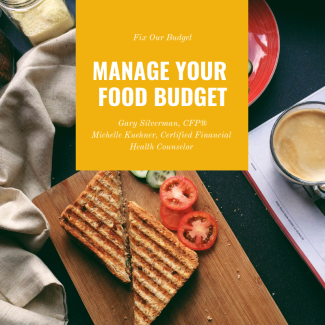
Gary, Michelle, and the Milkshake Dilemma Part 2
By Gary Silverman, CFP®
Last time, Michelle Kuehner (the president of my firm) and I were discussing how to manage your food and grocery spending. You can catch up on the conversation on the blog at our website. Basically, we ended after sharing this: After you budget your housing, transportation, savings, and debt repayment, the remaining 20% of your income (based on the American Consumer Credit Counseling guidelines) will include your food. And your insurance. And clothing. And your hobby spending… In other words, everything else. Let’s return to our conversation to see if Michelle can help narrow this down.
Gary: It takes more than guidelines to manage your food budget, right?
Michelle: That’s right. And it takes more than knowing your income—although that’s important, too. So, start off by figuring out what you are actually spending right now.
G: How will that help me with my future spending?
M: If you track your spending, you are more likely to not leave certain things out when creating a budget. It’s easy to forget all of the things you purchase in a month, even if you buy them often. For example, a cat owner may forget to budget kitty litter, even though they buy it once or twice a month. Also, if you shop somewhere like Walmart for your groceries, you may pick up other household necessities when you are there. If you are being mindful of your tracking, you will note the $70 spent on food and the $30 spent on household cleaners. If you just count all of your Walmart spending as groceries, you may think you are overspending on food, even if you are not.
G: I don’t think many people track their spending prior to attempting to work on a budget.
M: Right. This may be why many become so frustrated with the process. If they track their spending for a month or two, and then compare how much they are spending to the guidelines we discussed last time, they will have a starting point based on their own lives.
G: So, if someone tracks all of their spending, and all of the other categories such as housing and transportation are in line, but their “other,” which includes food, is too high, should they go on a diet?
M: Don’t worry Gary, we should be able to find a way to fit in those milkshakes.
G: Whew!
M: As you know, when it comes to finances and grocery shopping, there’s no such thing as “one-size-fits-all.” Each family will have to make adjustments according to their own lives. If their house is paid off, they may have more money for savings, or for dining out. As you like to say, “It depends.” If a family takes these first steps and is still coming up short, they may want to reach out for help or read more online about finding discounts in different areas of their lives.
G: I think I saw a coupon for Arby’s in the paper…
M: That’s a start.
Gary Silverman, CFP® is the founder of Personal Money Planning, LLC, a Wichita Falls retirement planning and investment management firm and author of Real World Investing

